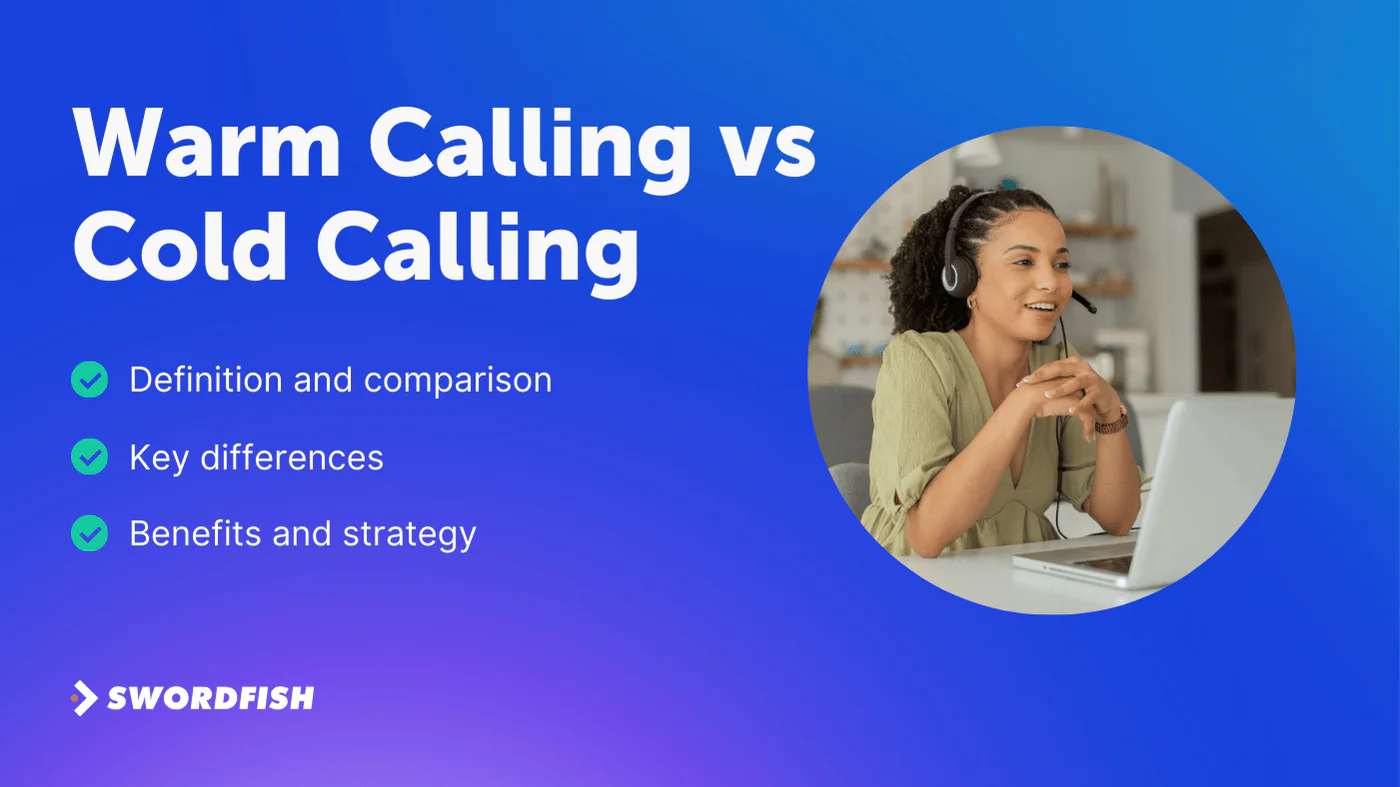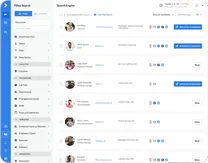
Want to maximize your sales strategy but not sure how or where to begin with your outreach methods? Today, we’re going to cover two major strategies within the selling toolkit: warm calling and cold calling. Each has its strengths and is very instrumental in the generation of leads, nurturing of relationships, and closing of deals.
Mastering the right use of warm and cold calling in your sales outreach can make a tremendous amount of difference in making your work more efficient and productive. Warm calling is where the salesperson engages prospects who have previously interacted in one way or another with the business or are even aware of its services.This can include:
- Attending a webinar you’ve hosted
- Downloading a whitepaper from your website
- Engaging with your brand on social media
💡 In sales, preparation is everything. Knowing your prospect and being able to tailor your message makes all the difference. That’s where warm calling shines.
On the other hand, cold calling is all about reaching out to potential clients who may have never heard of your company. It’s a challenging but valuable approach for expanding your reach and discovering new opportunities. We’ll explore how these methods differ, their benefits, and how you can leverage tools like Swordfish.ai to maximize your success rate.
Let’s jump in 👇
Understanding Cold Calling: The Basics and Benefits
Cold calling, simply stated, is the classic sales technique whereby you contact potential customers who never had any relationship with your business. Think of it as an unsolicited call, really just hoping to strike up a conversation that will lead to a sale. Somehow overwhelming, cold calling withstood the test of time and for good reason—it works, provided you do it the right way.
Why does cold calling still matter? Despite the rise of digital marketing strategies, cold calling remains effective for several reasons:
- Generating new leads: Cold calling can help uncover potential customers who might not have discovered your business through other channels. This expands your reach and taps into new markets.
- Immediate feedback: One of the biggest advantages of cold calling is the ability to get instant reactions from prospects. This direct interaction can provide valuable insights into their needs and pain points.
- Building a human connection: When done well, cold calls can humanize your brand. By engaging in meaningful conversations, you can build rapport and trust with potential customers.
- Valuable for certain industries: Certain sectors, like real estate, recruitment, and financial services, still heavily rely on cold calling to generate high-quality leads.
However, there are some issues involved with cold calling. It is much more a matter of doggedness and perseverance when you consider pitching to somebody who might be getting several unwanted calls every day. That said, armored with the right tools and strategies, cold calling can certainly become an almost indispensable part of your selling arsenal.
What Is Warm Calling? A Personalized Approach
Probably one of the more evolved approaches in getting in touch with prospects might be a warm call—there is some amount of prior familiarity or interaction with your business. It is the subtle art of starting a conversation with prospects who may have manifested interest in your products or services by attending a webinar, downloading a white paper, or getting a referral from someone.
Unlike cold calling, which often is a shot in the dark, warm calling uses these existing touchpoints to help drive far more engaging and receptive dialogue. When people you contact have some level of brand awareness, you can really dress your message with relevant interests and needs, allowing it to be more engaging. It feels more like the continuation of an interaction that began elsewhere, rather than a self-serving sales pitch.
“By reaching out to individuals who already have a baseline awareness of your brand, you can tailor your message to resonate more deeply with their interests and needs. This makes your outreach feel more like a continuation of a previous interaction rather than an unsolicited sales pitch.”
The essence of warm calling lies in the preparation and personalization. Before picking up the phone, sales representatives should delve into available data on the prospect. What was their last interaction with your company? What content have they engaged with? Armed with this knowledge, your call can be far more relevant and impactful.
Warm calls mostly provide better conversion. Prospects are known to be more open and responsive to a brand with whom they have the capacity for familiarity. It is not just about making a sale, but about building rapport. The more you nourish those relationships over time, the better your chances for closing deals, and in the end, avenues for long-term customer loyalty.
Using Swordfish.ai or other tools, it’s incredibly easy to gather the data needed for prospects to enable even warm calling. With Swordfish.ai, key information about leads helps the sales teams tailor very personalized outreach strategies. This, of course, by design means your warm calls are going to be more relevant.
Comparing Warm Calling and Cold Calling: Key Differences
The primary distinction between warm calling and cold calling lies in the initial relationship with the prospect. In warm calling, there is a prior interaction or at least some form of awareness about your company. This might be due to a previous inquiry, a meeting at a networking event, or even a connection through social media. Because of this preliminary connection, warm calling is often perceived as less intrusive and more welcomed by the prospect.
| Aspect | Warm Calling | Cold Calling |
| Initial Relationship | Pre-existing | None |
| Prospect Awareness | Yes | No |
| Conversion Rates | Higher | Lower |
| Perception of Intrusiveness | Less Intrusive | More Intrusive |
| Ease of Tailoring Message | Easier | Harder |
On the other hand, cold calling is making unsolicited calls to potential customers who have never had any contact with your business. This approach is a bit more abrupt and generally gets more resistance. But on the bright side, cold calling, when conducted with proper techniques and tools, can be an effective means of gaining additional customers and acquiring new markets.
The conversion rates are also very different. Warm calling usually creates higher conversion rates because of the pre-existing familiarity and personalized approach. Prospects are likely to engage in meaningful conversation if they already know your brand or have had a positive initial interaction.
“Prospects are more likely to engage in a meaningful conversation when they already recognize your brand or have had a positive initial interaction.”
Cold calling, though generally having lower conversion rates, is not without its merits. It allows sales teams to cast a wider net, uncover new leads, and create opportunities that might not have been available through other channels. While it may require more effort to build rapport and trust, the potential for reaching untapped markets is substantial.
Both strategies require a tailored approach to be effective. For warm calling, leveraging the existing knowledge about the prospect can help in crafting a more personalized and impactful message. In contrast, cold calling benefits greatly from thorough preparation and the ability to quickly establish relevance and interest.
Ultimately, the quality of either delivery will depend on both prospect data quality and the quality of the call itself. This is where tools like Swordfish.ai excel: drives warm and cold call efforts with detailed, accurate prospect information. Now, having a firm grasp of the data on hand, you’ll be better positioned to understand your leads and tailor your messaging to remarkably improve the chances of success.
How Comprehensive Prospect Data Boosts Your Sales Efforts
Accurate and full-fledged prospect data is integral to both cold and warm calling strategies. Therefore, it is crucial for successful sales. Swordfish.ai provides detailed prospect data to power up your outreach with a better understanding of your prospects, using their data on job titles, company roles, and social media activities for personalization of messaging. Personalization sits at the heart of warm calling. Prospects really value the fact that you have done homework.
Firstly, understanding your prospects through data—such as job titles, company roles, and social media activities—enables personalized messaging. This personalization is key in warm calling, as prospects appreciate when you’ve done your homework.
For cold calling, detailed data transforms random outreach into targeted efforts. Tailoring your pitch to address prospects’ potential pain points makes your call more valuable and less intrusive, even if there’s been no prior interaction.
Swordfish.ai‘s extensive database provides up-to-date information, helping sales teams identify trends and refine strategies. Understanding which industries or job roles respond well guides future efforts towards promising leads.
Furthermore, comprehensive data improves follow-up effectiveness. Detailed records of past interactions inform timely and relevant follow-up strategies, turning potential missed opportunities into closed deals.
In summary, quality prospect data at your fingertips strengthens your sales team’s ability to make effective calls. Tools like Swordfish.ai supply you with dynamic insights from the raw data to drive conversions and sell more.
Get a free trial 👉 https://swordfish.ai/


 View Products
View Products



